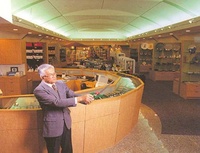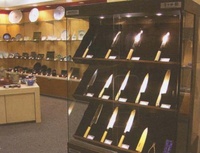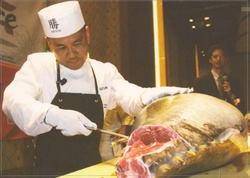>> Part 1
The initial target for Mr. Nakajima’s new sushi venture was Japanese immigrants, particularly businessmen. Quite impressed with the fare, they began bringing their American clients to try something novel and extraordinary. After their first experience with sushi,most novices becameaddicts. Kawafuku’s sushi bar had only seven seats, and it was always packed.
Kawafuku’s Chef Saito became the first sushi chef in America. Mrs. Saito was his waitress. In just four years, the couple saved $30,000, quite a fortune then, and decided to go back to Japan where, with their nest egg, they opened a beautiful sushi bar in Ginza.
Six months later, aware of Kawafuku’ssuccess, Mrs. Morishita, owner of Eigiku, and two other Little Tokyo restaurants, sought Kanai-san’s advice; she too wanted to open a sushi bar. She was counseled to “import” a good Japanese sushi chef. And so, 19-year old Chef Ono made it to this country.
Later, two more chefs came from Japan. One, Chef Mashita went to work at Tokyo Kaikan. At certain times of the year, it is impossible to make toro maki-sushi, a large roll with a fatty tuna center, as the fish disappears from the market. For a good substitute, Chef Mashita mixed California avocado and crab meat for the roll’s center, thus creating the “California Roll.” Heresy! cried the sushi traditionalists; but the concoction hit instantly. Copycats in the East then created the New York roll—filled with chopped smoked salmon and cucumber strips; and the Philadelphia roll—filled with cream cheese. Sushi had become Americanized1.
In 1968, the sushi craze jumped its ethnic boundaries, and ventured into the rest of Los Angeles. Possibly trembling at both knees with uncertainty and excitement, Mr. Kubo opened Osho on Pico Boulevard, choosing a fabulous location adjacent to the 20th Century Fox lot. He had only thirty seats, and his establishment was always packed with the fussiest clientele: movie stars. The need to import additional sushi talent became apparent.
As if scheduled to be launched at the most appropriate time, NBC-TV aired its series Shogun, based on the James Clavell novel. For five consecutive evenings, America devoured the odd soap opera2. People became infatuated with the American rendering of samurai culture.
In their traditional syncretism, Americans matted samurai fiction and Japanese cuisine. The effect on sushi was like a steroid shot on a starving athlete. Many more Japanese chefs opened restaurants in the Wilshire area, and the craze spread all the way to the shores of Santa Monica. At some time, Wilshire Boulevard became known as Sushi Row.
One of the proudest moments in Kanai-san’s life took place in 1985:
“Prime Minister Nakasone and President Reagan became very good friends,” Kanai recounts. “Regan invited the Premier to visit the United States, and feted him at a magnificent party at the Yamato Restaurant in Century City. It made me enormously proud to see that the Yamato chef had chosen for hors d’oeuvre SUSHI!”
Currently, there is a yearly competition, sponsored by the California Rice Commission, to select the best sushi chef3. The Gold Medal Winner for 2008 (June 10) was Tomoharu Nakamura of San Francisco’s Sanraku Four Seasons restaurant4. He won with his combination “Morikomi Plate,” featuring his signature ingredients5, presented in a dazzling decor.
Top competitors were Chefs Koji Ogawa of Fresno’s Sakura Chaya (formerly with the Japanese Kitchen); Billy Ngo of Kru Restaurant, Sacramento; Akifusa Tonai of Kyo-ya Restaurant, San Francisco; Takuya Matsuda of Sushi Bar Nippon, San Diego; and Aung Soe of Geisha House, Hollywood6. (What, nobody from Little Tokyo?)
Since the basis for top sushi is the quality of the rice used, the California Rice Commission is very proud that in all the competitions, the medium-sized rice grain raised by California growers contributed to the success of the winners.
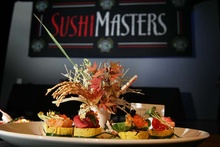
2009 SushiMasters Competition. Chef Nakamura’s beautiful winning dishes (Photo courtesy California Rice Commission)
As an excellent entrepreneur and top visionary, Kanai-san has helped create and foster the sushi culture in America. Since sushi and sake often go together, the development of izakaya (Japanese pubs) and top sake sommeliers quickly became a new wave for additional business success.
Mutual Trading Company’s Display Room is a real museum of sushi; every aspect of its culture is displayed in separate mini-galleries.
One shows the most modern, refrigerated showcases for sushi preparation. A large glass case, integral to the front counter, exhibits a collection of precious sharpening stones. Another area displays fabulous samples of the crafts of tarai (bare wood trays), and lacquerware. One more holds china, from unadorned tokkuri (traditional sake bottles) to the most exquisite samples of serving ware.
Still other sections display chefs’ and servers’ clothing; marvelous noren (short, divided curtains common in Japanese restaurants) in linen or aizome (indigo-dyed cloth); and maneki neko, Daruma, and other luck-attracting figures. There’s even one with a set of samurai armor, plastic of course, and other pieces of daring décor.
But most fascinating is MTC’s collection of cutlery. Here are the finest knives you have ever seen, at prices from a modest hundred to a couple of thousand dollars. One piece in particular looks as shiny and elegant as a chokuto7, ready for the classiest daimyo’s waist, confirming that the Japanese art of steel forging still lives triumphant.
Kanai-san has recorded his experiences in a small book (in Japanese) entitled: Seiko ho no chakuso (An Original Way of Doing Business). I asked him whether he intended to have the book translated, and he quipped:
“Maybe Reiko, your wife, can do it…”
The world of sushi has changed dramatically, since Kanai-san’s first attempted to create a clientele for it in America. Nobu Matsuhisa has now emerged as one of the top “authorities” in the field of sushi (2009). He operates nine restaurants in the USA, Melbourne, London, Hong Kong and Tokyo. He has written at least three books on sushi: Nobu West; Nobu: The Cook, and Nobu Now.
A less self-centered book, for those who want to learn more, is The Zen of Fish by Trevor Corson (Harper Collins, 2008), in which the author discusses the lore, tradition and history of sushi in America. Further information is available on the Sushi Masters website, www.sushimasters.com. And there is even a monthly paper, Sushi & Sake, entirely devoted to sushi culture.
From Albania to Zimbabwe, people all over the world are addicted to sushi for health reasons8. Based in Southern California, Southern Tsunami operates over 2,500 outlets in North America. Sushi has gone orbital, and schools are not graduating enough chefs to meet the global demand.
If you want to learn the art, Yuji Matsumoto’s California Sushi Academy in Venice, and Andy Matsuda’s Sushi Chef Institute at the old Maryknoll compound offer accelerated courses at handsome fees. You can also fly to Japan, and pay about $4,500 for a five-week course and a diploma…or even go online to www.sushitrainer.com.
In a masterful stroke of marketing genius, on September 3, 2008, Kanai-san launched the Sushi Institute of America with a most ambitious designator: “a place of learning and training for professional chefs and culinary enthusiasts.” Its location is at 843 East 4th Street, in Los Angeles, just a few blocks away from Mutual Trading. SushiMaster pundit Katsuya Uechi, of the Katsuya Restaurant emporium heads the new institution.
With over ten thousand sushi places in the United States and more opening practically daily, the need for well-trained sushi chefs is more than apparent. Uechi-san wants his pupils to learn only the classical sushi style. Unlike other sushi eminences, Uechi Sensei disdains “signature” creations, including such parvenus as the California Roll and other misguided concoctions.
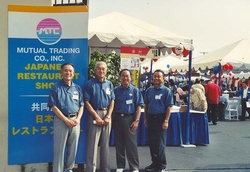
MTC Core management Team Oct 2001, Mr. Kanai second from the left (Photo courtesy of Mutual Trading Co, Inc.)
Consider for a moment MTC’s position in this new adventure of commercial verticality. It can now provide for restaurateurs interested in entering the field of sushi all the needed ingredients, tools, machinery, décor, knowledge, trained talent, and energy needed to retain sushi in its purest form. The opening ceremonies for the Sushi Institute attracted a formidable crowd of dignitaries, business persons, and press, press, press. Who could ask for anything more?
Is there a cloud in this brilliant horizon? Maybe. Suzumo Machinery Company, developer of robotic sushi, has improved its technology to the extent that it’s now possible to robotically create maki-sushi in seconds with the nori either inside or outside the roll, depending on cultural preferences9. Other machinery developed in Switzerland has also robotized the creation and delivery of the product.
But, says Kanai-san as he pats an imaginary nigiri in his hands, “Nothing will ever compare with the handmade product!&rdqou;
You take it from there.
Notes:
1. http://www.barrypopik.com/index.php/new_york_city/entry/new_york_roll_sushi/
2. It ran on NBC consecutively from September 15 through 19, 1980.
3. The contest was known as the 2008 SushiMasters State Finals. Chef Nakamura got gold medals for his Morikomi Plate and Signature roll.
4. Chef Nakamura won again in 2009 in the expanded SushiMasters Finals East/West Challenge with the same presentations. The other contenders were Randy Noprapa, Maneki Neko in Falls Church, Virginia; Tshio Furihata, Moshi Moshi restaurant in Miami Beach, Florida, and Hyun Min Suh of Sushi Ran in Sausalito, CA. See: http://www.sushimasters.com/competition.htm
5. Simply laver, some greens, seasonal seafood, egg for the Morikomi, and three varieties of California rice.
6.The Sacramento Bee. June 11, 2008.
7. A small sword with a straight blade.
8. “Global Sushi Business,” an NHK report. June 21, 2008. http://www.nhk.or.jp/nhkworld/index.html
9. See the NHK report cited above.
*This story first appeared in the East San Gabriel Valley’s Japanese Community Center’s “Newsette” in January 2009.
© 2009 Edward Moreno





